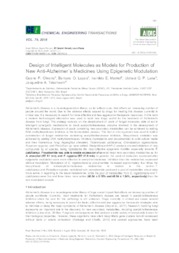Design of intelligent molecules as models for production of new anti-Alzheimer's medicines using epigenetic modulation.
Design of intelligent molecules as models for production of new anti-Alzheimer's medicines using epigenetic modulation.
Autoria: OLIVEIRA, G. P.; LOPES, B. A.; MARRIEL, I. E.; LANA, U. G. de P.; TAKAHASHIA, J. A.
Resumo: Alzheimer's disease is a neurodegenerative illness, so far without cure, that affects an increasing number of people around the world. Due to the adverse effects caused by drugs for treating this disease currently in clinical use, it is necessary to search for more effective and less aggressive therapeutic resources. In this work a modern technological alternative was used to build new drugs useful for the treatment of Alzheimer's disease from fungi. This strategy consists on the development of pools of fungal molecules able of act in intelligent synergistic mechanisms to block acetylcholinesterase, enzyme involved in the development of Alzheimer's disease. Expression of pools containing new secondary metabolites can be achieved by adding DNA methyltransferase inhibitors to the fermentative process. This fast in vitro approach was used to build a combination of fungal metabolites containing acetylcholinesterase inhibitors. Biosynthesis elicitation was achieved by adding DNA methyltransferases inhibitors (hydralazine and procainamide) to solid culture media and then filamentous fungi Aspergillus chevalieri, Talaromyces calidicanius, Clonostachys rogersoniana, Fusarium nygamai, and Penicillium sp. were added. Straightforward HPLC analysis showed elicitation of new compounds by all species, being hydralazine the most effective epigenetic modifier especially towards T. calidicanius. Procainamide was able to enable expression of several major new secondary metabolites as for A. chevalieri (RT 51 min), and F. nygamai (RT 21.5 min). In general, the pools of molecules expressed after epigenetic modulation were more effective in acetylcholinesterase inhibition than the metabolites expressed without modulation. Modulation of C. rogersoniana by procainamide increased approximately four times the biosynthesis of antiacetylcholinesterase metabolites in relation to the control. T. calidicanius and Penicillium species modulated with procainamide produced a pool of metabolites about twice more active in regarding to the basal metabolome, while the pool of metabolites from C. rogersoniana and T. calidicanius were five and three times more active (40.34 ± 0.15% and 48.54 ± 1.34%, respectively) than the non-modulated extracts.
Ano de publicação: 2019
Tipo de publicação: Artigo de periódico
Unidade: Embrapa Milho e Sorgo
Palavras-chave: Doença, Doença neurodegenerativa, Fungo, Medicamento, Moléculas fúngicas
Observações
1 - Por padrão são exibidas publicações dos últimos 20 anos. Para encontrar publicações mais antigas, configure o filtro ano de publicação, colocando o ano a partir do qual você deseja encontrar publicações. O filtro está na coluna da esquerda na busca acima.
2 - Para ler algumas publicações da Embrapa (apenas as que estão em formato ePub), é necessário ter, no celular ou computador, um desses softwares gratuitos. Sistemas Android: Google Play Livros; IOS: iBooks; Windows e Linux: software Calibre.
Acesse outras publicações
Acesse a Base de Dados da Pesquisa Agropecuária (BDPA) para consultar o acervo completo das bibliotecas da Embrapa.

